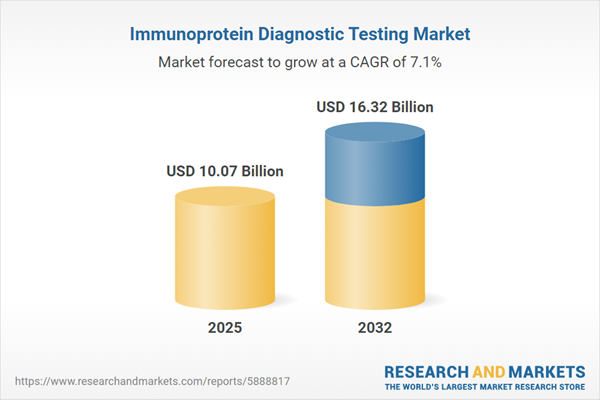Speak directly to the analyst to clarify any post sales queries you may have.
In the evolving immunoprotein diagnostic testing market, senior decision-makers are prioritizing solutions that support precision, integration, and operational agility. As health systems confront advancing standards, timely market intelligence is essential for guiding effective planning and strategic positioning.
Market Snapshot: Immunoprotein Diagnostic Testing Market Growth
From 2024 to 2025, the global immunoprotein diagnostic testing market experienced steady growth, with indications of ongoing expansion through 2032. Healthcare providers are increasingly adopting immunoprotein assays to improve diagnostic accuracy and disease tracking in varied clinical environments. Research and development investments are driving advancements in assay reproducibility and standardization. Enhanced system connectivity now allows more robust interoperability, complemented by targeted healthcare IT funding that accelerates the adoption of data-centric diagnostics. This environment facilitates collaborative laboratory operations and supports the broader transition to integrated, interoperable testing frameworks—enabling durable operational gains and supporting diverse healthcare stakeholders.Scope & Segmentation: Immunoprotein Diagnostic Testing Industry
- Assay Types: Includes antibody-based assays for major immunoglobulin classes (IgA, IgE, IgG, IgM), total antibody testing, antigen and autoantibody tests that aid disease management and comprehensive immune function analysis in clinical pathways.
- Technologies: Encompasses platforms such as chemiluminescent immunoassays, ELISA, fluorescence polarization, lateral flow, and Western blotting, each contributing to higher sensitivity, efficiency, and adaptability across increasing laboratory workloads.
- End Users: Spans diagnostic laboratories, clinics, hospitals, and research institutes implementing immunoprotein diagnostics tailored to their workflow, compliance, and care-delivery objectives.
- Applications: Supports detection and monitoring for autoimmune diseases (multiple sclerosis, rheumatoid arthritis, Sjogren syndrome, type 1 diabetes), cardiovascular disease risk assessments, infectious disease evaluation (COVID-19, HIV, hepatitis, influenza), and oncology biomarker studies.
- Sample Types: Utilizes a range of biological samples—plasma, serum, urine, and whole blood—enabling laboratories to flexibly match collection methods to case requirements, ensuring broad compatibility with healthcare system practices.
- Geographic Coverage: Covers the Americas, EMEA (Europe, Middle East, Africa), and Asia-Pacific, capturing key differences in regulatory frameworks, policy shifts, and cross-border compliance requirements affecting adoption and deployment.
- Company Coverage: Features comparative benchmarking of industry leaders such as F. Hoffmann-La Roche, Abbott Laboratories, Siemens Healthineers, Thermo Fisher Scientific, and additional market players to inform partnership, procurement, and competitive strategy.
Key Takeaways: Strategic Insights for Senior Decision-Makers
- Automation and modular systems are decreasing reliance on manual workflows, enabling quick responses to new clinical priorities and improving laboratory flexibility.
- Advancements in risk assessment and novel patient monitoring pathways support precision medicine strategies, allowing leaders to better manage complex patient populations and optimize care trajectories.
- Upgraded interoperability streamlines integration across diverse diagnostic technologies and helps organizations efficiently manage regulatory compliance and resources within laboratory environments.
- Strategic investments in domestic manufacturing, supplier relations, and digital infrastructure have improved resilience in the face of shifting regulatory and supply conditions.
- Market access strategies are regionally adapted: reimbursement considerations lead in the Americas, regulatory harmonization drives best practices across EMEA, and rapid technology adoption steers growth in Asia-Pacific settings.
Tariff Impact: Navigating Shifts in U.S. Trade Policy
Recent adjustments in U.S. diagnostic import tariffs are prompting organizations to review sourcing, procurement, and risk management. This has reinforced a shift toward domestic suppliers and broader use of contract contingencies, while supporting greater supply chain transparency to maintain operational resilience during ongoing policy changes.
Methodology & Data Sources
This report synthesizes current literature review, targeted interviews with executives, and scenario modeling. Expert perspectives have been integrated, ensuring an accurate assessment of evolving regulatory, operational, and market trends influencing immunoprotein diagnostic testing decisions.
Why This Report Matters
- Enables senior leaders to optimize operational, investment, and compliance strategies as immunoprotein diagnostic testing standards evolve.
- Delivers timely insight for supplier managers and risk teams targeting business continuity and resilience in dynamic market conditions.
- Facilitates data-driven planning to maximize competitive positioning and guide regional business development strategies.
Conclusion
In a transforming immunoprotein diagnostic testing market, organizations drawing on actionable intelligence and flexible strategic frameworks will be well-positioned to manage complexity and sustain long-term performance.
Additional Product Information:
- Purchase of this report includes 1 year online access with quarterly updates.
- This report can be updated on request. Please contact our Customer Experience team using the Ask a Question widget on our website.
Table of Contents
3. Executive Summary
4. Market Overview
7. Cumulative Impact of Artificial Intelligence 2025
Companies Mentioned
The companies profiled in this Immunoprotein Diagnostic Testing market report include:- F. Hoffmann-La Roche Ltd
- Abbott Laboratories
- Siemens Healthineers AG
- Thermo Fisher Scientific Inc
- Danaher Corporation
- Ortho-Clinical Diagnostics, Inc.
- bioMérieux SA
- DiaSorin S.p.A
- Bio-Rad Laboratories, Inc.
- Fujirebio Inc
Table Information
| Report Attribute | Details |
|---|---|
| No. of Pages | 185 |
| Published | November 2025 |
| Forecast Period | 2025 - 2032 |
| Estimated Market Value ( USD | $ 10.07 Billion |
| Forecasted Market Value ( USD | $ 16.32 Billion |
| Compound Annual Growth Rate | 7.1% |
| Regions Covered | Global |
| No. of Companies Mentioned | 11 |









